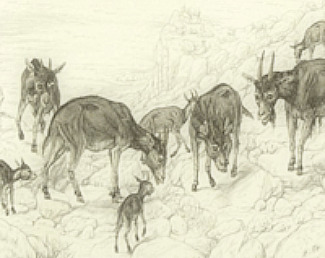Researchers at the ICP explain the physiology of Myotragus balearicus

The Myotragus balearicus is an extinct mammal similar to a goat that belongs to the family Bovidae. All the Myotragus fossil data has been found in Mallorca, Menorca, Cabrera and Dragonera. The first Myotragus balearicus was descovered in the beginning of the 20th century and since those early days, it has been at the centre of many paleontological studies. All thanks to its remarkable characteristics, fruit of an evolution in terms of insularity.
The islands and their fossil legacy are authentic laboratories of evolution for palaeontologists. In fact, we can say that they are experiments in evolution, due to the fact that the islands have many determinant environmental factors: small geographic area, limited resources, and trophic limited by the absence of large mammal predators. The fossil islands also give us a proper time perspective to study the evolution, thanks to the scale of geological time. A variable that the study of the islands today cannot provide us with.
Myotragus lived more than 5 million years on one of the islands. A very long time for a species to survive, especially in an area as small as an island, which means limited and fluctuating resources. That is what led researchers to wonder how this species had been able to survive more than twice as long as their mainland relatives.
The results of histological thin section of a large sample of Myotragus' bones, with which the bone tissue and its growth pattern was studied, show that Myotragus were physiologically closer to a crocodile (reptile) than to a mammal. The histology showed that Myotragus' bone grew unlike any other mammal, at a slow pace and flexible, stopping periodically its growth, reaching maturity at very advanced ages which meant a significant increase in longevity; similar to existing crocodiles. The explanation of why this happened is simple. Mammals are endotherms (warm-blooded) and, unlike cold-blooded species, spend a lot of energy to maintain body temperature constant. When resources are scarce, some individuals chose to burn less energy, i.e., individuals with a lower metabolism. This implies, however, grewing at a much slower pace, reaching maturity later and living longer.
The results of the study published in the article "Physiological and life history strategies of large mammal fossils in a resource-limited environment" in the renowned scientific journal Proceedings of the National Academy of Science (PNAS) suggest that although Myotragus was an endothermic mammal, they could experience lethargic seasons when weather conditions brought a lack of resources and made life difficult for them. The abundance of Myotragus' fossil found in caves suggests the possibility of these mammals using the caves to pass the difficult seasons, lowering metabolism and reducing vital functions.
Currently, some deer or goat-like bovidae can control the costly maintenance of a constant body temperature (endothermy) in a very critical period by generating a temporary fluctuation of body temperature (heterothermy). However, the only large mammal that hibernates is the bear. Bears are dangerous animals that suffer little or no predation. In addition, during their hibernation, they can wake up at any time and their temperature never falls below 20 º C. Bears and Myotragus balearicus shared the absence of threats from predators, because Myotragus lived on an island. This enabled them not only to reduce their metabolism in difficult moments, but also to stop their growth, delay the age at which they reproduce, extend their longevity (life years) or cease feeding at critical moments.
Today, scientific experiments are conducted to study the rhythms of life and longevity. Researchers study the reactions of invertebrates and small mammals (mice) under conditions of stress and lack of resources. Observations conducted with by this type of research point to the increased longevity or duration of the life of these animals. The results presented by ICP provide an example which supports this hypothesis and explains the evolutionary reasons for this increase in longevity. Reducing the pace of life and increasing longevity are favoured under conditions of stress and lack of resources. Thus, research in palaeontology supports research in other fields such as medicine. Thanks to this interdisciplinarity, the study of a goat-like bovidae that evolved in natural laboratory conditions (islands) could reveal the mechanisms that influence the physiology of humans and the causes of longevity.
References
"Physiological and life history strategies of a fossil large mammal in a resource-limited environment". Meike Köhler, Salvador Moyà-Solà. PNAS (2009).

